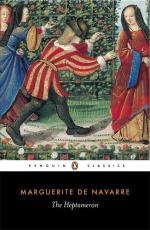Beside the divines who sought an asylum at Nerac, there were various noted men of letters, foremost among whom we may class the Queen’s two secretaries, Clement Marot, the poet, and Peter Le Macon, the translator of Boccaccio’s Decameron. This translation was undertaken at the Queen’s request, as Le Macon states in his dedication to her, and it has always been considered one of the most able literary works of the period. With Marot and Le Macon, but in the more humble capacity of valet, at the yearly wages of one hundred and ten livres, there came the gay Bonaventure Desperiers, the author of Les Joyeux Devis; (1) other writers, such as John Frotte, John de la Haye and Gabriel Chapuis, were also among Margaret’s retainers.
1 Livre de Depenses de Marguerite d’Angouleme.
She herself had long practised the writing of verses. It was in 1531, and at Alencon, that she issued her first volume of poems, the Miroir de l’Ame Pecheresse, (1) which created a great stir at the time, for when it was re-issued in Paris by Augereau in 1533 (2) the Sorbonne denounced it as unorthodox, and Margaret would have been branded as a heretic if Francis had not intervened and ordered the Rector of the Sorbonne to withdraw the decree censuring his sister’s work. Nor did that content the King, for he caused Noel Beda, the syndic of the Faculty of Theology, to be arrested and confined in a dungeon at Mont St. Michel, where he perished miserably.
1 Brunet’s Manual, 4th ed., vol. iii. p. 275.
2 A second edition
also appeared at Alencon in the same
year.
Margaret thus gained the day, but the annoyance she had been subjected to doubtless taught her to be prudent, for although she steadily went on writing, sixteen years elapsed before any more of her poems were published. In the meantime various manuscript copies, some of which are still in existence, were made of them, notably one of the poem called “Debat d’Amour” by Margaret, and re-christened “La Coche” by her secretary, John de la Haye, when he subsequently published it in the Marguerites de la Marguerite. This manuscript is enriched with eleven curious miniatures, the last of which represents the Queen handing the volume bound in white velvet (1) to the Duchess of Etampes, her brother’s mistress, whose qualities the poem extols. The Queen of Navarre was on the best of terms with this favourite, to whom in one of her letters she recommends certain servants.
Margaret was not only given to versifying, but was fond of’ framing devices, which she inscribed upon her books and furniture. At one time she adopted as her device a marigold turning towards the sun’s rays, with the motto, “Non inferiora secutus,” implying that she turned “all her acts, thoughts, will, and affections towards the great Sun of Justice, God Almighty.” (2)




